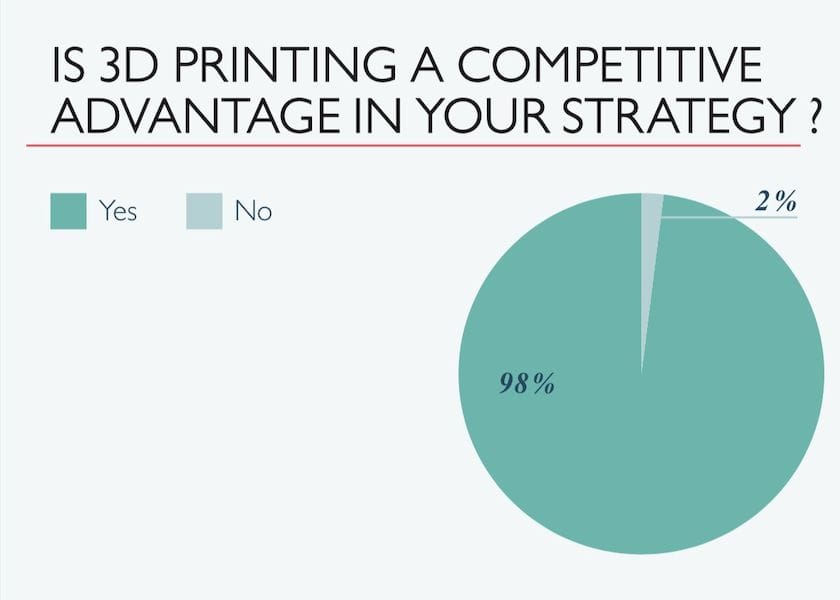
3D print service Sculpteo performs an extensive annual survey of the industry.
Last week they released the results of their latest version, the “State of 3D Printing 2018”. The survey investigates the benefits found by their clients, which are largely industry and number more than 1000 respondents, making the results valid. Let’s take a look inside to see what interesting trends are now visible.
The survey is quite detailed and has plenty of results, but some of the trends discovered are worth noting here.
The major finding is that most companies appear to be accelerating their use of 3D printing and are correspondingly increasing their spending on the technology, one way or another. Sculpteo says:
This year, companies have been more confident with their use of 3D printing. They actually dedicated larger budget to their additive manufacturing activities.
This year, we see an 11% increase, showing that companies perfectly integrated this manufacturing technique in their product development process.
In total, 70% of the respondents increased their expenses for 3D printing this year, against 49% last year.
These indicate that companies are truly discovering how to make direct benefits by using 3D printing technologies, through innovative design and even production. While the technology of 3D printing has been around for many years, its uptake among companies lags for years as incumbents gradually make their way through a lifecycle of understanding of how best to leverage 3D printing.
Individuals in these companies must learn that 3D printing exists, learn how to use it in the most basic form, learn how to design optimally for 3D printing, invent a new form of product for their operations and finally put it into production. For many this process takes years to get through.
Based on this survey, it may be that we’ve reached a bit of a turning point where more companies than not are pursuing the technology.
Indeed, one of the survey findings says this:
A majority of our respondents have competitors using 3D printing as well, they are actually 74% this year against only 59% last year. Once again, it shows that more and more companies are implementing additive manufacturing in their strategy, it is now a reliable and common production or prototyping process for many businesses.
And they’re making better use of 3D printing, likely through more experience:
46% of our respondents saw a greater return on investment this year, and 49% got about the same as last year.
While 3D printing has traditionally been a prototyping technology used by product designers, Sculpteo reports that 41% of their respondents are now using 3D printing for production purposes, slightly higher than last year. I suspect this number will sharply increase in coming years as several manufacturers are now developing 3D printers specifically for larger volume production purposes.
As one might expect, the proportion of those 3D printing in metal has grown significantly, now 36%, which is significant. Metal 3D printing is most used for production purposes – since the material is the same as used in the final product – whereas much of the plastic printing is used for research and product development.
Sculpteo reports that the majority of respondents now own their own 3D printer(s) at 66%, a rise of 13% over last year. While this may sound like bad news for a company providing 3D print services, it seems to be the opposite: more than likely companies still use 3D print services for access to more complex and refined 3D printing equipment than can be purchased and operated on site.
And the printers they are buying seem to be increasingly SLA rather than plastic extrusion. This is likely because there are now many very good options for resin-based equipment that are easy to use and produce superior results.
One very dramatic result is that the percentage of “3D Print Rookies” has decreased from 41% to only 15% in this year’s results. Evidently the population is getting far more experienced with the technology, a sign of maturity.
A quarter of respondents say they intend on “offering clients customized products and limited series”, suggesting that the best capabilities of 3D printing technologies are now not only understood, but being put to work in business.
Not surprisingly, respondents still suggest that the two most important factors are the availability and cost of materials, and the material capabilities of the 3D printers. This definitely explains the extreme interest of many 3D printer manufacturers in the marketing of professional 3D printers able to address those material needs.
The biggest barrier to additional growth is still the cost of 3D printing. But I am confident that with the new ventures working on production solutions, there will be far lower cost options for many companies to consider in the near future.
The bottom line on this report seems to be that the industry is very healthy and should be for the foreseeable future, as companies have now discovered how to properly leverage the technology.
And they won’t be giving that up.
Via Sculpteo

